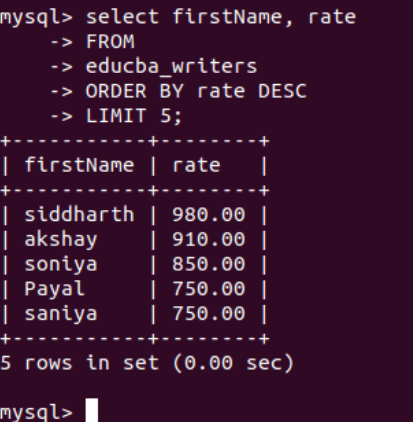

In that case, it is tough to know the query returns result from which rows. Amazon Aurora MySQL-Compatible Edition (Aurora MySQL) supports the non-ANSI compliant but popular with other database engines LIMIT OFFSET. Without using Order By clause, you will get the result in an unspecified order. The user needs to use the Limit clause with the Order By clause. In that case, Limit clause arguments, offset, and the count is equivalent. The following visual representation explains it more clearly: NOTE: If you specify only one argument with the Limit clause, MySQL assumes this to determine the maximum number of rows for returning output from the result set. The offset of the row starts from 0, not 1.Ĭount: It specifies the maximum number of rows you want to return. Offset: It specifies the number of a row from which you want to return. Table_name: It is the name of the table that contains your column name. A couple of weeks ago I posted an alternative to ORDER BY RAND() when using MySQL which uses MySQLs LIMIT syntax to jump to a record chosen at random based. The following are the syntax of using Limit query in MySQL:Ĭolumn_list: It is the name of the column that you want to return. To get only the specified rows from the table, MySQL uses the LIMIT clause, whereas SQL uses the TOP clause, and Oracle uses the ROWNUM clause with the SELECT statement. It improves the performance of the query and even stops having crashed the system when the table contains a large number of data.

In other words, if you are not interested in getting all the rows returned from the query, use the MySQL Limit clause with the SELECT statement. It is essential in such a case when the table contains thousands of rows, or you want to return only the recently inserted data. This query accepts only one or two arguments, and their values should be zero or any positive integer. The Limit clause works with the SELECT statement for returning the specified number of rows only. The LIMITclause in MySQL is used to limit the number of records that are returned from the query result. Note that, if you only specify one argument out of the two, MySQL assumes that you have specified the count argument.MySQL Limit query is used to restrict the number of rows returns from the result set, rather than fetching the whole set in the MySQL database. For instance, if you want to return the first 3 rows, then you set the count to 3. The count is used to specify the maximum number of rows you want to return.For example, if you set the offset as 2, the result-set is returned from row 3 onwards. Offset is used to specify the number of a row from which you want to return the result-set.
#Mysql limit code
Syntax of MySQL LIMIT SELECT expression FROM table_name LIMIT offset, count Code language: SQL (Structured Query Language) ( sql )

LIMIT takes one or two numeric arguments, which must both be nonnegative integer constants, with these exceptions: Within prepared statements, LIMIT parameters can be specified using placeholder markers.
#Mysql limit update
LIMIT is widely used along with the SELECT statement but can be used along with the UPDATE or DELETE statements as well. The LIMIT clause can be used to constrain the number of rows returned by the SELECT statement. MySQL LIMIT is used to restrict the number of rows that are returned in a result-set. However, if you only want to display the top three students who scored the highest in Maths, MySQL provides you with the LIMIT clause. Suppose you want to display the list of students in a table, in descending order of marks in Maths. Limit will display limited records Count will count the number of records See the following query codeSelect count() From database Where salary < 1000. In this tutorial, we will learn the MySQL LIMIT clause.


 0 kommentar(er)
0 kommentar(er)
